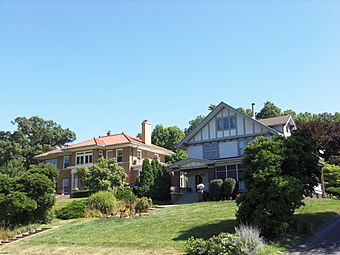McClellan Heights Historic District facts for kids
Quick facts for kids |
|
|
McClellan Heights Historic District
|
|

Houses on River Street that overlook Lindsay Park
|
|

Location within city
|
|
| Location | Roughly bounded by city limits, E. River Dr., East St., Jersey Ridge and Middle Rds., Davenport, Iowa |
|---|---|
| Area | 188.2 acres (76.2 ha) |
| Built | 1905-1940 |
| Architect | Temple and Burrows, et al. |
| Architectural style | Late 19th and Early 20th Century American Movements, Late 19th and 20th Century Revivals |
| MPS | Davenport MRA |
| NRHP reference No. | 84000328 |
| Added to NRHP | November 1, 1984 |
The McClellan Heights Historic District is a large historic area in Davenport, Iowa, United States. It covers about 188 acres. This special district was added to the National Register of Historic Places in 1984. At that time, it included 354 buildings that helped show the area's unique history and style.
Contents
What is McClellan Heights Like?
McClellan Heights is the biggest neighborhood in the eastern part of Davenport. It is located next to the Village of East Davenport. The area stretches from Jersey Ridge Road to the Bettendorf city limits. It also goes from River Drive up to Middle Road.
This neighborhood has about 400 houses built between 1894 and 1940. McClellan Heights is known for its many hills and deep valleys called ravines. The streets here follow the natural shape of the land. This means there are many winding roads and lots with unusual shapes. The southern part of McClellan Heights has many trees, which makes the neighborhood very pretty.
The area was built from south to north. Before World War I, four very large mansions were constructed here. This made the neighborhood popular with wealthy families. Many early residents were from the Netherlands and New England. Because of its park-like setting and great views of the river, this neighborhood is still a popular place to live today. The houses are in excellent condition. Even the few brick streets in the neighborhood are still in great shape.
A Look Back: The History of McClellan Heights
This area was once known as Camp McClellan during the American Civil War. That's how the neighborhood got its name! It was the largest of five training camps for the Union Army in and around Davenport. The land for the camp belonged to Thomas Russel Allen from St. Louis, Missouri. It was a huge area, more than 300 acres.
A part of Camp McClellan was called Camp Kearney. Here, the government held 277 men from the Sioux tribe as prisoners. There were also 16 women, two children, and one person from the Ho-Chunk tribe. These men were involved in the Dakota War of 1862 in Minnesota. President Abraham Lincoln changed their death sentences, so they were kept as prisoners instead. After the war ended in 1865, the camp was closed. The buildings were torn down after the Native Americans left Camp Kearney in 1866.
The land was given back to Ann R. Allen, Thomas Allen's wife. In June 1900, a group called the Grand Army of the Republic (GAR) held a gathering there. People wanted to turn the old camp into a state park. Civil War veterans, the GAR, and local citizens supported this idea, but it never happened.
By the early 1900s, the Allen family had moved to Belgium. Several people tried to buy and develop the land, but they all failed. Finally, a promoter traveled to Belgium to meet the family. He was able to buy the land for the Camp McClellan Improvement Company. William Richter was the company's president. Amos Cutter, who had developed the Oak Lane Historic District, was put in charge of building McClellan Heights.
There were special rules for people who built houses in this new area. For example, one house could not block another house's view. Also, each house had to cost twice as much as the land it was built on. No businesses were allowed either. There was even an officer whose job was to make the area beautiful. This person would make repairs, care for plants, pull weeds, and remove snow and ice.
Cool Houses: The Architecture of McClellan Heights
The houses in McClellan Heights show a mix-and-match style. This was popular at the time, rather than strictly copying old architectural styles. Builders used parts of older styles but in a more creative way. They might use just a few details to hint at an older look, instead of completely recreating it.
Some popular styles in the neighborhood include Tudor Revival and Mediterranean Revival. You can also see Colonial Revival forms, from New England styles to Dutch Colonial and Georgian.
The Prairie School style is also common here, but not in a strict way. There are only a few perfect examples of this style in McClellan Heights. Instead, you'll see its influence in wide roofs, horizontal windows, and upper story windows placed right under the eaves (the part of the roof that hangs over the walls). This Prairie School style was often mixed with the revival styles. It was also combined with two other American styles found throughout the neighborhood: American Craftsman and American Foursquare.
Important Places in the District




